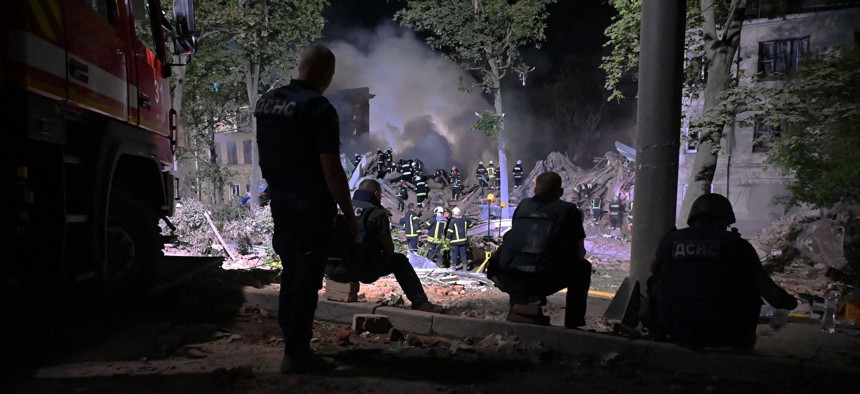
Rescue workers inspect the site of a destroyed hostel as a result of a missile strike in the second largest Ukrainian city of Kharkiv late on August 17, 2022, amid Russia's military invasion of Ukraine. SERGEY BOBOK/AFP via Getty Images
US Details Its Biggest Ukraine Arms Package Yet
The $3B package—announced on the country's independence day—includes more than 300,000 artillery and mortar rounds.
Updated at 2:12 p.m. on Aug. 24.
President Joe Biden announced the largest weapons and aid package yet for Ukraine on Wednesday, a $2.98billion package that would push total U.S. aid well past the annual budgets of at least eight federal programs, including the entire judicial branch.
The weapons and aid will be provided through the Ukraine Security Assistance Initiative and “will allow Ukraine to acquire air defense systems, artillery systems and munitions, counter-unmanned aerial systems, and radars to ensure it can continue to defend itself over the long term,” Biden said in a statement.
The latest package includes:
- Up to 245,000 rounds of 155mm artillery ammunition.
- Six additional National Advanced Surface-to-Air Missile Systems with additional munitions for NASAMS.
- Up to 65,000 rounds of 120mm mortar ammunition.
- Up to 24 counter-artillery radars.
- Puma Unmanned Aerial Systems and support equipment for ScanEagle UAS.
- VAMPIRE Counter-Unmanned Aerial Systems.
- Laser-guided rocket systems.
- Funding for training, maintenance, and sustainment.
Timed for the 31st anniversary of Ukrainian independence, the announcement arrived just five days after the previous one unveiled a $775 million package of advanced missiles, armored vehicles, and artillery. But while the weapons for Friday’s package will be drawn from U.S. stockpiles, items for the upcoming set will be purchased or ordered from industry, a senior defense official told Defense One on the condition they not be named.
This could mean longer delivery times to Ukraine, said John Kirby, the National Security Council’s coordinator for strategic communications. Though some things, like ammunition, could be sent quickly if industry has its own stockpiles ready to ship, more advanced platforms like drones or radar could take longer.
“It’s going to depend, quite frankly, on the item that we’re talking about,” Kirby said. “Not everything will have to necessarily be…built as of today, but some stuff probably will still need some production time to develop.”
He said the switch from Pentagon stocks to industry orders does not mean the drawdown authority approved by Congress is used up, and said the administration could still announce additional packages of military equipment to be sent to Ukraine directly from the military’s own stockpiles.
Biden is expected to speak with Ukrainian President Volodymyr Zelenskyy on Thursday to “update him on United States security assistance and congratulate Ukraine on its independence day,” Kirby said.
The almost $3 billion package will be the largest single chunk of the total of $13.7 billion that the United States has U.S. announced since Russia’s February invasion.
That total is more than the annual budget of some federal programs, such as the National Science Foundation ($9.2 billion) and the Small Business Administration ($1.7 billion), according to Statista. It is larger than the annual budgets of the federal judiciary ($9.7 billion), Congress ($6.6 billion), or the Executive Office of the President ($0.6 billion). It is creeping up on the budgets of the Environmental Protection Agency ($15.9 billion), if not NASA ($24.9 billion).
The $13.7 billion—plus whatever aid is committed before the fiscal year ends on Sept. 30—will push 2023 defense spending toward the $1 trillion mark, said Larry Korb, a defense budget expert with the Center for American Progress. After President Biden requested $813 billion, Congress decided to raise that amount to account for inflation and other projects. Ukraine and other costs, like amortization rates for the military’s retirement system, will push the total close to 10 figures, said Korb, a former naval flight officer who served as assistant defense secretary in the Reagan administration.
“The question is: Are you going to add to the deficit, which is now over $30 trillion?” Korb said. “How are you going to pay for it?”
In the last several weeks, the Pentagon has announced back-to-back massive rounds of military aid for Ukraine as Russian momentum has stalled. A second senior defense official who briefed reporters Friday said offered assurances that the Pentagon knows where all the aid and weapons are going.
“We have very detailed accountability measures to ensure that we are tracking from the moment that we have authorization to provide a capability from the moment that we move that capability via the U.S. Transportation Command to its destination across the border to Ukraine,” the official said.
“Then working with the Ukrainians, we also have information about how they are deploying these capabilities, how they're using them, and how they are consuming the capabilities that they need replenishment for. So very, very detailed tracking by my military colleagues, both here at the Pentagon, also at U.S. European command and now also with our Defense Attache Office that is reestablished in Kyiv.”
Jacqueline Feldscher contributed to this report.




